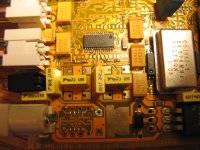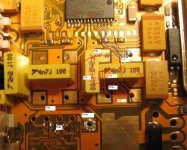Ah, geez. After listening exclusively to the DAC for a week--and enjoying it--I put on an LP this morning, then another, then another. . . . My Denon DL-103 + DB Systems moving coil phono stage is just so much more satisfying. For me, the DAC is good, the phono is great.
LPs: Laura Cantrell's Humming by the Flowered Vine and lots of Bach on DG Archiv.
LPs: Laura Cantrell's Humming by the Flowered Vine and lots of Bach on DG Archiv.
I have my PS modded HiFace feeding I2S into a ESS9022 DAC & it certainly doesn't sound thin. I imagine the Nuforce uDac's front end PCM2702 USB receiver is one of it's weak links.I have recently had the opportunity to audition the decco and the nuforce udac, both of which have the highly regarded sabre chips in them. The decco/nova product line has actually gathered quite a few awards as well.
Well, the decco had a great midrange, one to die for. It was well polished but nothing so groundbreaking that is worth the price tag.
Next the udac, it is not as polished, thin edgy sound. But I've only had it for a while.
The super pro with output transformers was a whole class above these two. Except the decco's midrange, it was superior in every aspect by a long way.
With Martin's experience above, it may be that this is just an ordinary one in stock form. But OPTs and good power it has tremendous potential.
With the Hiface + ESS DAC full 24/192 is supported & the DAC directly drives headphones - a great USB Hi-res solution
appreciate your inputs jkenny! For someone like me though, it is hard to get to the solution you have.
Hi Guys!
I'm still quite happy with my slightly modified super pro dac, powered by batteries. But there is one thing I'm curious about: Since my notebook has no digital outputs I'm forced to use the usb connection. So, I wonder if someone of you has the opportunity to compare the super pro's usb input to the digital inputs, preferably the optical toslink connection.
Are there any differences in sound?
Thanks!
Martin
Btw., one funny sidenote: With a conventional power supply I liked the op275 and the opa2604 best. I didn't like the opa2134 at all. But with the battery I prefer the 2134 over all the others I've tested! Don't know why, but battery powered the 2134 gives the most powerful, detailed yet smooth and non-fatiguing sound of all the four opamps I've tried.
I'm still quite happy with my slightly modified super pro dac, powered by batteries. But there is one thing I'm curious about: Since my notebook has no digital outputs I'm forced to use the usb connection. So, I wonder if someone of you has the opportunity to compare the super pro's usb input to the digital inputs, preferably the optical toslink connection.
Are there any differences in sound?
Thanks!
Martin
Btw., one funny sidenote: With a conventional power supply I liked the op275 and the opa2604 best. I didn't like the opa2134 at all. But with the battery I prefer the 2134 over all the others I've tested! Don't know why, but battery powered the 2134 gives the most powerful, detailed yet smooth and non-fatiguing sound of all the four opamps I've tried.
I found no difference sonically, between the usb and optical inputs.. although I never tried the toslink connection.
Are there any differences in sound?
Thanks!
Martin
Hi,
there is one technical difference in the Supepro between USB input and coaxial Toslink or PSDIF:
1) TOSLINK and PSDIF accept 24 bit, 193Khz data;
2) USB input accept max 24 bit 48Khz data.
So, to get the full resolution of HI-RES music which is still a niche product, but is going to be more and more diffused you need the TOSLINK or PSDIF input.
Being honest I have a 24bit, 96Khz music file downloaded for free from HDTracks.com and I do not get a clear difference between listening to the music in full format or downsampled to standard 16bit, 44Khz.
My impression, is that the clear improvement in sound quality of HI-REZ music is more due to careful and better recording than to the higher resolution of the format.
By the way I am now using the standard superpro (no mod) with the toslink input from a Mac notebook and the quality of the music for me is clearly better than by using my old (used bought) Meridian 508.20 CD player costing new 5000$ in 1995.
Renato
P.S. Can someone address me on the net (for instance in Mouser or RS-online) to a battery PSU I could buy to test the difference with the standard PSU?
Hi ra7 and northernsky,
thank you both for your answers!
Northernsky, I only know about ready-to-use battery psu's which are quite expensive, like the SLAP ps on this page:
KingRex Power Supplies
For testing only it's really a great option to use the batteries of a battery powered drill. If you or a friend of you owns a good quality drill with two batteries and a charger, you can even listen to music non stop, because all the time one battery is in use and one can be recharched simultaniously. That's what I do. Of course the batteries have to be 12V ones. 9V batteries will drop below 9V quickly when in use, and below 9V the dac beginns to distort the signal. It doesn't matter if it's a Ni-Cd battery, works very well. Just get hold of a in-line fuse holder (I had one for car audio purpose lying around) and a fuse of a few amperes, a pair of alligator clamps for the battery connection and a standard 5,5/2,5mm dc plug.
It's all put together in a few minutes and it's more that worth the effort!
Martin
thank you both for your answers!
Northernsky, I only know about ready-to-use battery psu's which are quite expensive, like the SLAP ps on this page:
KingRex Power Supplies
For testing only it's really a great option to use the batteries of a battery powered drill. If you or a friend of you owns a good quality drill with two batteries and a charger, you can even listen to music non stop, because all the time one battery is in use and one can be recharched simultaniously. That's what I do. Of course the batteries have to be 12V ones. 9V batteries will drop below 9V quickly when in use, and below 9V the dac beginns to distort the signal. It doesn't matter if it's a Ni-Cd battery, works very well. Just get hold of a in-line fuse holder (I had one for car audio purpose lying around) and a fuse of a few amperes, a pair of alligator clamps for the battery connection and a standard 5,5/2,5mm dc plug.
It's all put together in a few minutes and it's more that worth the effort!
Martin
If you to hobby stores, they got some pretty good batteries in there... the kind used for model airplanes and cars. I got mine from Radioshack here in the US... 9V about 1500 Ah.
For the super pro, 9V is enough. It needs 5V minimum.
For the super pro, 9V is enough. It needs 5V minimum.
If you to hobby stores, they got some pretty good batteries in there... the kind used for model airplanes and cars. I got mine from Radioshack here in the US... 9V about 1500 Ah.
For the super pro, 9V is enough. It needs 5V minimum.
Well, this is odd. Perhaps you got a slightly different version of the super pro, but mine is specified from 9V to 24V, and exactly when my battery drops a small bit below 9V the bass lines in the music begin to sound distorted.
Hi,
just to complete what I know about a Superpro connected to a computer.
The audio configuration tool of my Macbook Pro notebook allows maximum 96Khz sampling rate from the Toslink output.
There is a relatively cheap chance to use the full capability of 192Khz by
the M2tech usb interface (99€) which allows for asynchronous connection of the
computer with the DAC to a maximum of 192Khz for both Windows or Mac computers.
See this thread if interested http://www.diyaudio.com/forums/digital-source/153191-m2tech-hiface-usb-spdif-24-192khz-asynch.html
Renato
just to complete what I know about a Superpro connected to a computer.
The audio configuration tool of my Macbook Pro notebook allows maximum 96Khz sampling rate from the Toslink output.
There is a relatively cheap chance to use the full capability of 192Khz by
the M2tech usb interface (99€) which allows for asynchronous connection of the
computer with the DAC to a maximum of 192Khz for both Windows or Mac computers.
See this thread if interested http://www.diyaudio.com/forums/digital-source/153191-m2tech-hiface-usb-spdif-24-192khz-asynch.html
Renato
yeah, yeah, I know, it's an old thread...
But just for all the future people, using this for reference on the Super Pro DAC 707:
THROW AWAY THE WALLWART ADAPTER, USE BATTERY POWER !!!
You won't believe the improvement it makes...
I pulled the battery out of my motorcycle, just to give it a try
that was now 7 hours ago,
I cannot stop listening...
😱
<Win7, J.River 15, toslink to battery powered DAC707, straight into Senn HD650>
But just for all the future people, using this for reference on the Super Pro DAC 707:
THROW AWAY THE WALLWART ADAPTER, USE BATTERY POWER !!!
You won't believe the improvement it makes...
I pulled the battery out of my motorcycle, just to give it a try
that was now 7 hours ago,
I cannot stop listening...
😱
<Win7, J.River 15, toslink to battery powered DAC707, straight into Senn HD650>
Yup, seriously considering that...
Can you point me where to connect the transformers ?
😛
picture "borrowed" from the Head Fi forum
< DAC 707 Mods - Head-Fi.org Community >
Can you point me where to connect the transformers ?
😛
picture "borrowed" from the Head Fi forum
< DAC 707 Mods - Head-Fi.org Community >
Attachments
Well, its been a while since I looked at that board. Usually, the output from the chip is routed to the opamps. You can pick up the signal straight after the chip. I cannot recall if this was marked on the 707 board. I bought the ebay board which uses the same chip, but is much easier to tap into.
Just put back a decent OpAmp, don't belive in all the urban legends about magical transformers... You won't be able to drive directly the cans with just the DAC.
You won't be able to drive directly the cans with just the DAC
That's what I thought....
Taking out an opamp, just to replace it with a complete amplifier (?)
Why not take a quality coupling cap instead ?
and, is it really needed ?
As far as I know, the CS4398 doesn't present a DC offset at it's analog outs
Cheers,
Empee
Actually, the 4398 has 2.5v offset at the output pins if memory serves. If you're just looking to drive cans the easiest way stick with the opamps. If you want great quality then it gets a little more complicated. Buffers, caps, transformers, they all can be used, but you need some kind of buffering for cans, except maybe high impedance cans.
- Status
- Not open for further replies.
- Home
- Source & Line
- Digital Line Level
- So many DACs, which to choose

